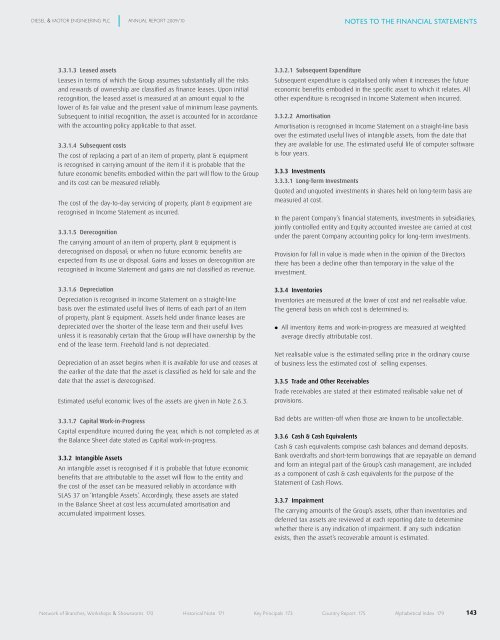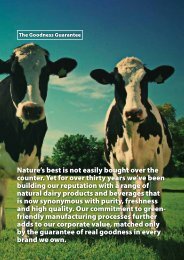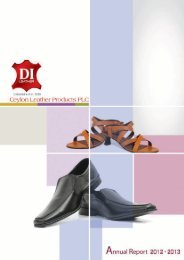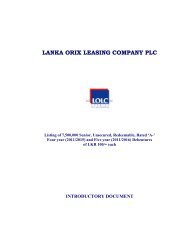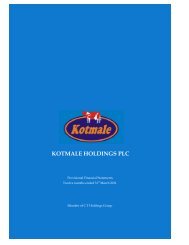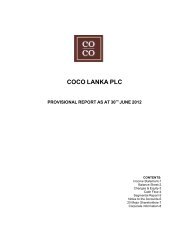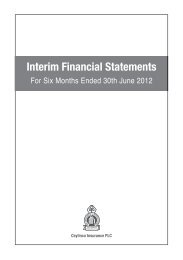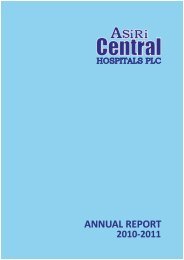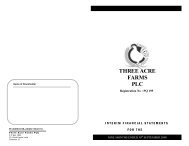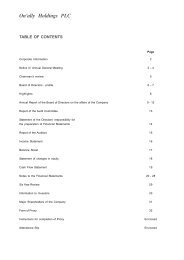directors - Colombo Stock Exchange
directors - Colombo Stock Exchange
directors - Colombo Stock Exchange
You also want an ePaper? Increase the reach of your titles
YUMPU automatically turns print PDFs into web optimized ePapers that Google loves.
DIeseL & MotoR eNGINeeRING pLC ANNUAL RepoRt 2009/10<br />
3.3.1.3 Leased assets<br />
Leases in terms of which the Group assumes substantially all the risks<br />
and rewards of ownership are classified as finance leases. Upon initial<br />
recognition, the leased asset is measured at an amount equal to the<br />
lower of its fair value and the present value of minimum lease payments.<br />
Subsequent to initial recognition, the asset is accounted for in accordance<br />
with the accounting policy applicable to that asset.<br />
3.3.1.4 Subsequent costs<br />
The cost of replacing a part of an item of property, plant & equipment<br />
is recognised in carrying amount of the item if it is probable that the<br />
future economic benefits embodied within the part will flow to the Group<br />
and its cost can be measured reliably.<br />
The cost of the day-to-day servicing of property, plant & equipment are<br />
recognised in Income Statement as incurred.<br />
3.3.1.5 Derecognition<br />
The carrying amount of an item of property, plant & equipment is<br />
derecognised on disposal; or when no future economic benefits are<br />
expected from its use or disposal. Gains and losses on derecognition are<br />
recognised in Income Statement and gains are not classified as revenue.<br />
3.3.1.6 Depreciation<br />
Depreciation is recognised in Income Statement on a straight-line<br />
basis over the estimated useful lives of items of each part of an item<br />
of property, plant & equipment. Assets held under finance leases are<br />
depreciated over the shorter of the lease term and their useful lives<br />
unless it is reasonably certain that the Group will have ownership by the<br />
end of the lease term. Freehold land is not depreciated.<br />
Depreciation of an asset begins when it is available for use and ceases at<br />
the earlier of the date that the asset is classified as held for sale and the<br />
date that the asset is derecognised.<br />
Estimated useful economic lives of the assets are given in Note 2.6.3.<br />
3.3.1.7 Capital Work-in-Progress<br />
Capital expenditure incurred during the year, which is not completed as at<br />
the Balance Sheet date stated as Capital work-in-progress.<br />
3.3.2 Intangible Assets<br />
An intangible asset is recognised if it is probable that future economic<br />
benefits that are attributable to the asset will flow to the entity and<br />
the cost of the asset can be measured reliably in accordance with<br />
SLAS 37 on ‘Intangible Assets’. Accordingly, these assets are stated<br />
in the Balance Sheet at cost less accumulated amortisation and<br />
accumulated impairment losses.<br />
notes to the Financial statements<br />
3.3.2.1 Subsequent Expenditure<br />
Subsequent expenditure is capitalised only when it increases the future<br />
economic benefits embodied in the specific asset to which it relates. All<br />
other expenditure is recognised in Income Statement when incurred.<br />
3.3.2.2 Amortisation<br />
Amortisation is recognised in Income Statement on a straight-line basis<br />
over the estimated useful lives of intangible assets, from the date that<br />
they are available for use. The estimated useful life of computer software<br />
is four years.<br />
3.3.3 Investments<br />
3.3.3.1 Long-Term Investments<br />
Quoted and unquoted investments in shares held on long-term basis are<br />
measured at cost.<br />
In the parent Company’s financial statements, investments in subsidiaries,<br />
jointly controlled entity and Equity accounted investee are carried at cost<br />
under the parent Company accounting policy for long-term investments.<br />
Provision for fall in value is made when in the opinion of the Directors<br />
there has been a decline other than temporary in the value of the<br />
investment.<br />
3.3.4 Inventories<br />
Inventories are measured at the lower of cost and net realisable value.<br />
The general basis on which cost is determined is:<br />
� All inventory items and work-in-progress are measured at weighted<br />
average directly attributable cost.<br />
Net realisable value is the estimated selling price in the ordinary course<br />
of business less the estimated cost of selling expenses.<br />
3.3.5 Trade and Other Receivables<br />
Trade receivables are stated at their estimated realisable value net of<br />
provisions.<br />
Bad debts are written-off when those are known to be uncollectable.<br />
3.3.6 Cash & Cash Equivalents<br />
Cash & cash equivalents comprise cash balances and demand deposits.<br />
Bank overdrafts and short-term borrowings that are repayable on demand<br />
and form an integral part of the Group’s cash management, are included<br />
as a component of cash & cash equivalents for the purpose of the<br />
Statement of Cash Flows.<br />
3.3.7 Impairment<br />
The carrying amounts of the Group’s assets, other than inventories and<br />
deferred tax assets are reviewed at each reporting date to determine<br />
whether there is any indication of impairment. If any such indication<br />
exists, then the asset’s recoverable amount is estimated.<br />
Network of branches, Workshops & showrooms 170 historical Note 171 Key principals 173 Country Report 175 Alphabetical Index 179<br />
143


